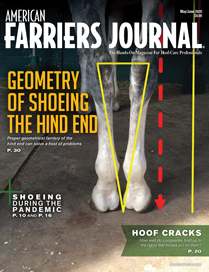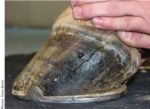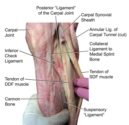Advertise Follow Us
American Farriers Journal

View Archived Issues
May/June 2020
Volume: 46
Edition: 4
American Farriers Journal is the “hands-on” magazine for professional farriers, equine veterinarians and horse care product and service buyers.
-
Table Of Contents
Table Of Contents
Shoeing During a Pandemic
Iowa farrier observes an unexpected uptick in his local business as equine enthusiasts stay home and rideRead MoreFarrier Business Advice During COVID-19
Farriers share business ideas to help during the Corona virus pandemic.Read MorePatching Hoof Wall Cracks with Composite Materials
Research puts hoof crack composites to the testRead MoreWhy David Duckett’s Foot Balancing Method is Still Confused with Russell’s
Maryland farrier Matthew Taimuty revisits the differences 20 years after writing Duckett vs. RussellRead MoreHow Hind End Geometry Improves Performance and Balance
Cornell University Farrier Steve Kraus explains the geometrical effects of trimming and shoeingRead MoreMaryland Farrier’s Toe Length Protocol Keeps Show Horses in Top Form
Tape measure, dividers and hoof protractor help maintain proper foot parametersRead MoreEquine Reciprocating Systems: New Parts and Novel Attachments
Understanding the anatomical parts and novel attachments critical to reciprocating systems in the modern-day equine will lay the farrier’s groundwork for achieving soundnessRead MoreThrough surveying three cases, Dr. Scott Morrison discusses his approach and shares footcare tips
Veterinarian and farrier Scott Morrison of Rood and Riddle Equine Hospital gives tips with challenging casesRead MoreFarriers Can Add Value to their Practice with Adhesive Applications
Acrylic, urethane and polyurethane are among the options available to enhance a hoof-care businessRead MoreHow Does Your Farrier Business Measure Up?
2020 International Hoof-Care Summit Surveys reveal practices of attendeesRead MoreResearch Journal: May/June 2020
The information, ideas and opinions expressed are those of the author and do not necessarily represent those of the United States Department of Agriculture.Read More -
Featured Articles
Featured Articles
Shoeing During a Pandemic
Iowa farrier observes an unexpected uptick in his local business as equine enthusiasts stay home and rideRead MorePatching Hoof Wall Cracks with Composite Materials
Research puts hoof crack composites to the testRead MoreEquine Reciprocating Systems: New Parts and Novel Attachments
Understanding the anatomical parts and novel attachments critical to reciprocating systems in the modern-day equine will lay the farrier’s groundwork for achieving soundnessRead More - Digital Edition
-
Online Extras
Online Extras

















